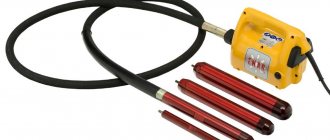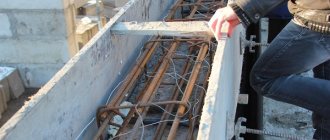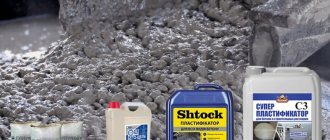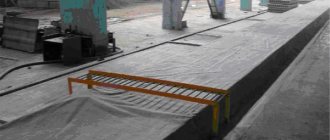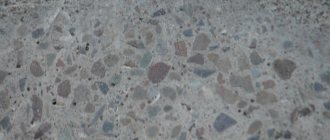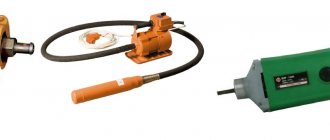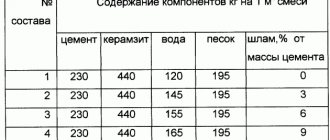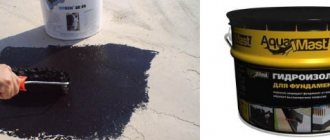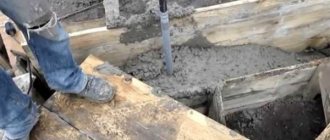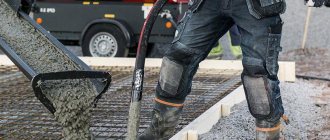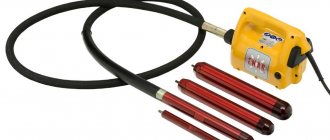March 11, 2016 Hand-held power tools, electric-pneumatic tools
The most important technological element in obtaining a durable monolithic concrete block after pouring the solution into the formwork is its compaction by squeezing out and displacing the remaining air. Previously, this was done by tamping the poured concrete or “bayoneting” - piercing with sharp pins. Modern monolithic construction technology uses a more effective method - vibration, under the influence of which the remaining air inside independently rises to the top. To create a vibration load, a special device is used - a concrete vibrator.
Process Benefits
The compaction process in concrete has a number of advantages:
- Vibration reduces the porosity of concrete stone. As is known, voids in liquid pulp account for 1-2%. If they are not removed, they will fill with air and the cement will lose strength and water resistance. Vibration effects can solve this problem. High-frequency mechanical vibrations with low amplitude increase the mobility of the liquid pulp, which causes the outflow of air bubbles.
- Vibration vibrations make it possible to increase the viscosity of the sand concrete mass and prevent delamination. Thus, the finished concrete stone will be more uniform. In addition, oscillatory movements increase the fluidity of the liquid mass, which allows it to more evenly fill the formwork shape. Vibrating concrete allows you to obtain a ready-made product that is resistant to cracking, mechanical stress, seasonal temperature fluctuations and other negative environmental factors, with an increased service life.
The process of applying oscillatory pulses has clear rules that must be followed in order to achieve a good result.
- It is recommended to immerse the oscillating device to 80% of its length. This allows you to qualitatively mix the lower and upper layers of the conglomerate.
- The entire concrete composition must be subjected to vibration. The area of action of the tool should be located so that the wave from its operation covers the entire solution.
- Contact of the pins with the reinforcement should be avoided. It is recommended to place the vibrator at some distance so that the space around the metal element is not free.
- It is not recommended to insert the vibrator close to the edge, to joints and corners.
- There should be no crater left after removing the mechanism.
Compacting concrete by deep vibration.
By submerged vibrators or by exciting the cement-sand mass, oscillatory movements are transmitted through the formwork or mold. As a result of this, the particles of the mass components receive impulses, and the mixture itself acquires the properties of a heavy liquid, that is, it liquefies, this is correct. In this case, vibration reduces or completely destroys contacts between particles and weakens internal friction. This action removes excess air from the cement, making it easier for it to fill the molds.
Oscillation frequency is the main parameter. It can vary over a wide range and is determined by the type of vibrator. The vibration frequency has different effects on filler particles of different sizes. Before vibrating concrete, you should carefully select the tool depending on the size of the filler.
PVC Tiles Sold Skin
- manufacturer: YugSpetsZashita
- by purpose: garage floors, shop floors, gym floors
PVC floor tiles Sold Skin have a texture reminiscent of compacted sand or stone chips. The coating is as smooth as possible, but not slippery. Resistant to falling heavy objects and moving heavy equipment. Doesn't crack, doesn't prick. ...
more details
Purpose of the vibrator
In the process of pouring the mixture, it is necessary to strive to obtain a homogeneous composition, to eliminate, if possible, the appearance of water and gas bubbles, and to avoid unevenness in filling the working volumes. If a reinforced concrete structure is created, in addition, it is necessary to achieve high-quality adhesion between the mixture and the reinforcing grid.
Since during the production of reinforced concrete products, as well as during the laying of the mixture, air is introduced into the mass of the solution in any case, there is a need to remove it. Otherwise, this can lead to a porous structure of the finished concrete, which reduces its quality. The best way to remove air bubbles is by vibrating the solution. This vibration is created by a deep vibrator.
At the same time, the air moves upward, the fluidity of the composition improves, and the filler in the solution mass is dispersed with better uniformity. The elimination of voids and liquid pockets strengthens the bond between the reinforcement and the mixture. As a result, when hardened, a denser structure with better characteristics is obtained.
We suggest you read: Choosing a bathhouse for a summer cottage
Advantages and disadvantages
The concrete vibrator has the following advantages:
- reduces solution consumption;
- improves the characteristics of concrete;
- increases the operational period of the entire structure;
- eliminates the need to carry out the procedure manually, which has a positive effect on the speed of construction;
- increases the hardening time of the solution;
- ease of use;
- wide range of tools;
- increases the adhesion of the solution to the reinforcement;
- No special skills are required to use.
Flaws:
- high price;
- additional energy costs.
Signs of sufficient compaction of the concrete mass
One of the signs is the absence of bubbles in the concrete mixture.
Compaction work with concrete can be carried out in two ways: manually and mechanically. However, it is difficult to achieve good results with manual compaction. Vibration is also not always possible to obtain the required homogeneity. On the one hand, the mixture may not be completely compacted, and on the other hand, it may delaminate due to excessive vibration.
The degree of compaction can be correctly determined using several parameters:
- there is no settling of liquid conglomerate;
- laitance with sand floats to the surface;
- there are no air bubbles;
- After removing the vibrator nozzle, the surface of the conglomerate quickly closes.
DIY drill attachment
In order not to spend money on a concrete vibrator, you can make a drill attachment with your own hands. The main thing is to follow the step-by-step instructions.
Necessary materials
To make the nozzle you will need:
- Stainless steel pipe . A piece is required, length 50 cm, outer diameter 55 mm, machine thickness 1.5 mm.
- Roller bearings – 2 pcs. The outer diameter of such elements should be 52 mm.
- Metal circle . Its length should be 55 cm and its diameter 20 mm.
- Metal square rod . You will need such an element, 40 cm long and 2.5 cm on sides.
- Iron lid . The internal diameter of such a product should be 55 mm.
- Steel cable . The length of such an element will require up to 1 m and a diameter of 15 mm. The ends of the product are welded.
- PVC tube sleeve . The length of this product must be equal to the dimensions of the cable. Diameter – 55 mm.
- Sealant or epoxy glue.
- Bearing grease
Instructions
The first thing to do is to weld a square rod along its entire length to the rod. In this case, an indent of 15 mm is made at one end. It is performed to fix the bearing. The completed element is the working shaft of the structure.
After this, the following algorithm is followed:
1. A working shaft is inserted into a stainless steel tube. Bearings are fixed at both ends. The elements are pre-lubricated. They should sit firmly on the structure, but rotate freely.
2. An iron cap for the plug is fixed to the tube at the working end. To do this, use glue or sealant.
3. A hole is made at the free end of the shaft, strictly in the center. Length and depth – 15 mm. To fix the cable in it, another hole with a diameter of 4 mm is made perpendicular to the shaft axis with a distance of 7 mm from the end. It is carved.
4. The end of the cable is fixed in the hole with a clamping screw.
5. The PVC sleeve is fixed to the cable with the open end. It should overlap the junction by 5-6 cm. For a tighter and more reliable fixation, use a clamp.
6. The other end of the cable is fixed in the tool chuck. After this, it can be used for its intended purpose.
Note! To protect the nozzle from the negative effects of the solution, a rubber or plastic cover is placed on it during use.
Types of vibrators for concrete
Based on the principle of influence and location of installation, several types of these devices are distinguished:
- An internal (submersible, also known as deep) vibrator is used in cases where serious, heavy structures are being erected. If we are talking about private construction, these are the moments of making a foundation or a monolithic wall. From the name it is clear that it works when immersed in a mass of solution.
- The external vibrator is attached from the outside to the formwork. It is used when filling rather narrow, high structures with frequently located reinforcing mesh.
- The site concrete vibrator is used when pouring floor slabs and making paths.
As part of the production equipment, the deep concrete vibrator is used in the production of reinforced concrete blocks, slabs, monolithic lintels and other building elements. Thanks to the compaction of the poured mixture, the speed of work increases, productivity increases, and accordingly, a larger number of structures are produced in less time.
What is a portable device and how does it work?
A deep-type manual electric apparatus consists of the following parts:
- electric motor;
- flexible shaft with armor;
- sealed vibrating tip.
The main property of a portable vibrator is to create vibration from the inside and ensure maximum viscosity and adhesion of hardened and fresh liquid concrete in joints and with reinforcement.
Under the influence of such a device, the solution lies more densely, and compressed air is removed from it.
A construction vibrator compacts the concrete surface by lifting part of the compressed air upward and, as a result, completely removing it from the solution and replacing it with cement paste. At the same time, crushed stone and sand move towards each other, better and more compactly arranged according to the shape of the fill. The notched gaps around the reinforcement are also filled, producing adhesion of all layers and reducing the consumption of cement composition.
The portable type deep vibrator is divided into types, including:
- gasoline or pneumatic with a vibrating tip diameter from 25 to 100 mm;
- diesel (36-65);
- electric (70 mm).
How the device works
Using a vibrator, mechanical impulses are transmitted into the concrete plane, which act on the particles of the mixture, reducing the viscosity to fill small cracks. In electromechanical and motor devices, vibration occurs from the rotation of the eccentric. In pneumatic and hydraulic devices, work is carried out due to the difference in pressure between the air and the liquid component. Other types of vibrators affect the solution using an electromagnetic field and can be portable and standard with different tips.
This tool is equipped with several tips at once.
Portable devices are lightweight and compact. They are mainly used for small-scale work to compact concrete mixtures in small quantities. They are used in cases where it is not necessary to use a long shaft (more than 1.1 m). The device has fairly small dimensions, which makes it easy to transport and adjust the diameter of the vibrating needle. The devices are equipped with several tips for convenience. The body, made of metal, protects from impacts, and a special coating prevents corrosion. Can be powered by mains power or a built-in motor. The choice of operating mode depends on the diameter of the vibrating tip and is specified in the instructions for each specific type.
Operating rules for the unit
When working with the unit, the following rules must be observed:
- the composition should be poured from a small height, measuredly and evenly, each new layer of concrete should be approximately 0.4–0.5 m, no more;
- it is necessary to immerse the tip of the apparatus into the solution in a vertical direction, without allowing it to move horizontally;
- the distance between dive sites should be 8–10 diameters of the club tip;
- the impact areas must necessarily intersect, which excludes untreated areas;
- to ensure excellent adhesion of the layers of concrete mixture, the mace must be immersed at least 10 cm into the penultimate layer;
- the duration of treatment must correspond to the grade of concrete and the diameter of the vibrating tip;
- it is unacceptable to allow the tip to touch the reinforcement bars or formwork panels;
- you need to pull the working part of the device out of the solution smoothly and leisurely - the hole from the tip should be completely closed;
- a deep concrete vibrator is not used as a surface vibrator;
- Maintenance of the device must be carried out promptly and regularly.
Design and principle of operation of the tool
Figure 1. Vibrator for concrete
The device is electromechanical (sometimes pneumatic or gasoline equipment). It is used in the construction of structures and the production of reinforced concrete structures.
Any electric vibrator is equipped with an asynchronous motor, which has an unbalancing device on the shaft. Rotation of the rotor converts electricity into mechanical vibrations transmitted to the equipment, and through it to the cement mixture. The device helps reduce the porosity of concrete, improve its penetration into the smallest gaps, ensuring guaranteed setting.
The device creates high-frequency waves; they are transmitted into the solution. The industry produces a variety of tip designs capable of transmitting vibrations into the concrete mixture.
To create vibration, you need a vibrator attachment for concrete on a hammer drill or drill - an eccentric shaft. The existing eccentricity additionally loads the end or middle of the device rod. It is located inside a metal shell. Rotation is ensured by bearings, with their outer races fixed in guides, and the inner races connected to an eccentric rod.
Operating principle of internal vibrator for concrete
When performing compaction work, a vibrating mace (tip) is immersed in the solution. The diameter of the club can be 25–100 mm. The selection of the required tip is carried out depending on the type and grade of concrete, the level of reinforcement, and the form used for pouring. Certain types of work require the use of specific club diameters.
To connect fresh layers of solution, you need to bury the tip of the vibrator approximately 0.1 m into the previous layer. After vibration treatment, the contact of the layers is very high quality, the layers are tightly connected. Such unpleasant moments as the formation of cracks and cavities are reduced to the minimum possible.
We invite you to read: Plastic fittings: reviews. Plastic reinforcement for foundations: reviews. Application and characteristics of plastic reinforcement
To obtain maximum efficiency, it is important to correctly select the required diameter of the mace and correctly determine the impact zone. In good deep concrete vibrators, the processing area is 10 times larger than the diameter of the club. If the quality is questionable or the power is low, then during the dive the vibration speed decreases, which affects the area of action. Accordingly, incorrect selection can reduce productivity and reduce the quality of processing.
Incorrect use of equipment will not only not give the desired result, but will also cause damage to the resulting structure. Excessive exposure to vibration increases the chance of mixture delamination, which will weaken the strength and reduce the reliability of the element.
The duration of vibration treatment directly depends on the viscosity, fluidity and plasticity of the concrete mixture. The average time of vibration exposure of one place is from 10 to 60 seconds. After shrinkage is complete, when cement laitance is already visible on the surface, the treatment can be completed.
The distance at which you need to install the tip to process the next area depends on the radius of action of the deep vibrator. As a rule, this distance is one to one and a half radius of the tool compaction. When impacting a foundation, monolithic wall or other structure poured into the formwork, you need to ensure that the mace does not touch the formwork elements. The clearance between the tip and the formwork panel material should be at least 7–10 cm.
The most common submersible vibrators of the electromechanical type include an electric motor, a flexible hose (drive mechanism) and a working tip (mace or bayonet) that emits vibration. A powerful electric motor (1 kW or more) has one or three-phase power supply from an alternating current network. Using a flexible shaft, the length of which can be from 1 to 7 m, the rotation of the rotor is transmitted to the vibrating tip.
The vibrating nozzle is a stainless steel tube for resistance to corrosion from aggressive concrete mortar. To protect against moisture, the ends of the drive hose are sealed with rubber gaskets, and the nozzle has a polymer sheath. Inside the nozzle, a massive eccentric steel shaft rotates on a bearing.
The shape of the working part of the vibrating attachment can be cylindrical (mace) or conical (bayonet). The first is intended for compacting concrete in forms and formworks with normal reinforcement frequency. The second type of nozzle is used for dense reinforcing mesh of poured forms. The vibrator kit may include several vibration attachments and clubs of different diameters.
Types and characteristics
Vibration compaction of poured concrete is possible in three ways - immersion (c), smoothing (a) and vibrating together with the formwork (b).
Depending on the dimensions and other features of the compacted mass, three types of vibrators are used. Having a similar operating principle, different types of vibration compactors differ in design.
Deep vibrator
Also called submersible or internal concrete vibrator. Compaction occurs when the vibrating tip is immersed in the solution.
Depending on the shape, a vibrating attachment can also be called a vibrating bayonet, vibrating shovel or vibrating rod.
Based on the location of the engine, there are:
